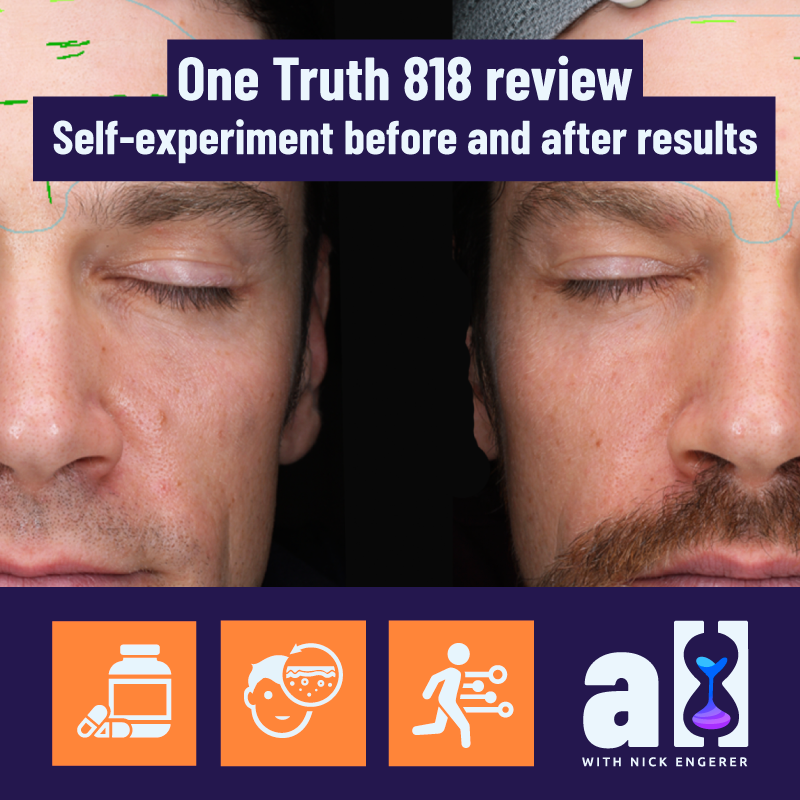Self-experimenting with GlycanAge - Before and after diet changes
GlycanAge test review & self-experiment
As we’ve learnt over the past few posts, glycans are incredible molecules with many important roles in the body.
Perhaps the most important of which is providing information to our immune system about what foreign molecules (i.e. diet, dust particles, bacteria, etc!) are friend and which are foe.
As such, they strongly regulate inflammation in to the body, and as we’ve learnt - they are impressively capable of predicting age-related disease onset.
Also, their ‘youthfulness’ can maintained by paying attention to certain lifestyle factors - chiefly diet, exercise, stress and sleep - monitoring them can help us track how we’re doing as we biohack our way to long & healthy lives.
In this post we’ll cover:
The role of glycans in immunity
How glycans are involved in the digestive system
How to use diet to improve GlycanAge
Why food is information for the immune system
Setting up a self-experiment for improving GlycanAge
Plus - snippets from our interview with world expert on glycans - Professor Gordan Lauc
Glycans regulate immunity
It is the role of glycans in immunity and disease related processes which makes them so important with respect to the aging process.
Such is their potential impact, that any personalised longevity strategy should likely include an effort to maintain youthful glycan characteristics.
A tumour cell being tagged with 'bad guy’ glycans (represented by the squares, circles, diamonds on cell membrane). Image credit: Gly-tech
“Youthful” in this context essentially means ‘anti-inflammatory’, meaning:
the immune system is not overactive
chronic inflammation is not present (or in advanced age, well managed)
the ravages of inflammaging (the negative feedback cycle of inflammation creating more damage & inflammation) are avoided
How Glycans impact the immune system
As we learned in our exclusive interview with world expert in all things glycans, Professor Gordan Lauc, glycans keep track of foreign materials in the body, tagging them as ‘friend’ or ‘enemy’ so that our antibodies know whether to activate inflammation (attack) or suppress inflammation (don’t attack).
“When antibodies are developed, they do not know whether a given foreign object will be an enemy, like a bacteria or a virus, or if it is friendly, such as food or a dust or something else they should ignore.
After the antibody binds to this foreign object, what happens next is determined by glycans. This very complicated process (glycosylation) is regulated by least 40 different genes.
These glycans decide whether antibody will kill a target cell (activate inflammation) or will it suppress inflammation”
Glycans, immunity and digestion
A major role of this immune surveillance process is centred on digestion. This is because the process of taking what we eat, and turning it into our own cells or energy requires active decision making on what should be allowed into the bloodstream.
Ultimately, food is “a foreign object” (using Prof. Lauc’s words above) that has entered the body.
This is clearly done for the purposes of providing fuel and supplying important nutrients, such as vitamins and minerals. However, much more than simple nutrition comes along for the ride.
This includes a host of ‘commensal’ (friendly) bacteria, and sometimes, bad ones, along with the occasional plant compounds that may stress the body (such as glycoalkaloids in the ‘nightshade’ family of veggies).
Our immune system has an important role to play in screening which of these compounds should be permitted to pass through the wall of the small intestine and into the blood stream.
We’ll revisit this in detail later in the post!
Using diet to self-experiment with GlycanAge
I (Nick here! Founder at A Longer Life) am currently experimenting with improving my GlycanAge through a change in my diet, and in this post, I’ll explain what changes I am making, why and how to make this self-experiment an effective one.
Changing diet to improve my GlycanAge - can it be done? Certainly - the question is - for relatively health people, how?
This self-experiment will explore a hypothesis related to increasing the diversity of plants in my diet and potential improvement in my GlycanAge.
However, before we get into the specifics on how this experiment will work, let’s introduce some important background knowledge to support the approach.
Improving GlycanAge with diet
Improving GlycanAge through changes in your diet can be either quite easy or mysteriously challenging.
If you’re someone who needs to lose some weight - you’re in luck. You can very likely improve you GlycanAge by simply losing weight. Look no further than our interview with Professor Lauc for the reasons why:
“A Longer Life: Could you point to a successful model for testing and improving your GlycanAge in a way that you can say, I know what did improved it, it was _____ ?
Gordan Lauc: One good example is weight loss. Losing extra weight helps the vast majority of people, because obesity is a big driver of inflammation.”
However, if you’re already at healthy weight, how to use your diet to improve GlycanAge is not immediately obvious. In fact, clinical research with GlycanAge and diet has shown this to be quite challenging (see below tweet & follow me on Twitter for more!).
1000 people were divided into groups eating very different diets
— Nick Engerer (@nickengerer) July 16, 2021
The outcome? It was impossible to predict which diet was best for whom
However, by monitoring glycans, that became possible. Their role in inflammation signalling can reveal - what diet works best for you? pic.twitter.com/D7AyNlzVfp
Improving GlycanAge with diet by eating more plants
Despite this challenge, I believer I have developed a solid hypothesis for testing how people at a healthy weight may be able to reliably improve their GlycanAge.
Through some serious homework, I also believe that this proposed change in diet that would also have relevance to other self-experimenters, and it could be replicated reliably.
This approach will leverage the sub-process of our immune system screening food particles and non-human organisms (i.e. bacteria) as they are processed in the duodenum (small intestine).
This critical step occurs before entering food materials and/or friendly bacteria are permitted to enter the bloodstream and intimately involves - you guessed it, glycans!
Food as information for the immune system
To continue down this line of reasoning, you need to adapt your thinking of the small intestine. Stop thinking of it as ‘inside’ your body, and start thinking of it as ‘outside’.
It is within the small intestine where a critical decisions is made - namely, what foreign materials from the diet are permitted to enter the blood stream.
Pictured: Intestinal villae, lines with intestinal epithelial cells (IECs) along with several other functional cells include macrophages (immune surveillance cells). Image Credit: Nature Reviews: Immunology
The small intestine is lined with “intestinal epithelial cells” or IECs for short. IECs are a single layer of cells with two key functions:
1) be a barrier to anything harmful - toxins, bad bacteria, viruses or antigens
2) act as a filter, whereby nutrients, electrolytes, water and beneficial bacteria are allowed into the bloodstream.
In this secondary function of ‘filtering’ where a detailed and highly important involvement of the immune surveillance system takes place.
The details are vastly complicated, but we can afford a useful simplification here.
Assuming you have tight junctions between the epithelial cells of the small intestine, only the foreign material ‘accepted’ by your immune system is permitted to pass through.
Anything else - and your immune system signals ‘attack’ - producing inflammatory signals.
IGG glycolisation (that’s science talk for how glycans are being used within the body - read more about this in the interview with Prof. Gordan Lauc) plays a critical roles in this screening process, and the ‘tagging’ of foreign material as friend or foe is at its peak level of activity at this epithelial junction.
Critically - this highly complex process includes many trillions of bacteria, which participate in the breakdown and processing of food materials by the body.
These so called ‘commensal’ bacteria are actually actively recruited and ‘pulled through’ the epithelial junctions by the immune system.
The commensal bacteria are pivotal to your broader bodily health, with your overall wellbeing depending on a vibrant and diverse population of these friendly bacteria in the gut.
Food as information
Local organic root vegetables from our weekly farmers market. Covered in healthy soil based commensal bacteria - just waiting to program your immune system.
The activities of food screening and bacterial populations in the gut are tremendously influential on inflammation in the body.
To better illustrate this, we’ll adopt a basic framework - where our diet is information about our environment.
This is the case because the food we eat, the bacterial populations in that food, as well as ‘antigens’ (‘bad things for us’) effectively ‘program’ our immune system.
In prehistoric times, this information was often life-saving, as it was critical for our bodies to become well adapted to the organisms, toxins and food sources around us in order to survive.
In this way, we evolved for our diet to signal “this is what your environment is like and thus how you should adapt to prepare for it”.
Now consider the modern environment, where food is sterilised and our environment is kept much cleaner than ‘nature’ could ever be. Your immune surveillance system is now cut-off from this critical source of information!
Why does this matter? Well, because in a relatively sterile environment, your body lacks enough exposure to healthy bacteria and the wide variety of food it needs to know when or when not to attack.
What does that mean? A sterile diet effectively means your immune system’s default mode is ‘attack’. The immune system, out of interest in self-preservation, will work to eliminate a foreign material it is not comfortable with (used to seeing).
Add it all up and you get - you guessed, more inflammation.
 |
Eating a diversity of plants programs immunity
In viewing food and organisms from the environment as information, we can begin to build up our glycan self-experiment in the following way.
If your body is not provided a diverse amount of information about the environment through a diversity of food and organisms through the diet, it will tend to react with ‘attack’ more often.
Through our framework: less information = more inflammation.
On the flip side the pathway to reconciling the overactive immune system is through providing ample information about the environment through the diet.
Dr Jenna Macciochi’s Immunity: The Science of Staying Well is one of the most up to date, accessible and helpful books out there on building a healthy immune system. (Amazon Affiliate link)
This will then support the immune system with a more comprehensive view of what foreign materials are ‘friendly’ and which are not.
This conceptual framework is precisely what Dr Jenna Macciochi lays out in her book Immunity: Science of Staying Well.
One of the key recommendations from this exceptionally insightful book is to eat a diversity of plants regularly, preferably local and organic ones.
The result will be a stronger immune system, which Dr Macciochi argues, is one of the only *real* ways to “boost your immunity”.
In her book, immunity expert Dr Macciochi says there is a valuable ‘rule of thumb’ for improving your immune system with diet.
What’s the rule? We’re glad you asked..
“A good rule of thumb for the biggest impact on health is to aim for over 30 different plants per week.
Whereas the opposite is also true. Eating 10 or few has a potentially damaging effect on the microbiota”
Why is this the case? It’s all about diversity of information about the environment.
And that information is programmed in the body via your glycans.
GlycanAge self-experiment: A diet with diversity of plants
My GlycanAge as of April 2021 is already ‘favourable’. But that’s not good enough for a longevity focussed biohacker now is it?
How low can we go?!
Coming full circle, this logic leads naturally to the experimental hypothesis:
“By programming the immune system with a diversity of plant information (local & organic where possible), chronic inflammation will be reduced as the immune system learns more about what is friend and what is foe, leading to an improvement in the Glycan Age”
The is precisely the hypothesis that this self-experiment will evaluate. So let’s get down to it!
My GlycanAge was first measured in April 2021.
My GlycanAge is 30, whereas my chronological age is 35.
According to Prof. Gordan Lauc, this is a great result.
“A Longer Life: What is a “good” GlycanAge result Gordan?
Gordan Lauc: Anything which is younger than your chronological age, I would say it’s good.
It’s also important to not worry about the absolute number, because the absolute number is also strongly affected by genetics.
Approximately 30-50% of the GlycanAge is determined by your genes, you cannot fix it.””
Self-experiment: Starting conditions & control
This result does make sense. In the 6 months leading up to this test, I maintained optimal levels of physical activity (training for sprint triathlons), a healthy balanced diet (eating small meals across the day, mostly vegetarian but with animal protein 3-5x/week), sleeping fairly well (Oura ring sleep scores at 75-85 on average) and well managed stress levels.
So in each of the four levy lifestyle factors (diet, exercise, sleep, stress) for my GlycanAge, things were in tip-top shape.
Do you think self-experiments are totally rad? So do we!
Subscribe to be notified when we announce the results from the GlycanAge before & after!
In this self-experiment, beginning from 1 May, I will eat 30+ plants per week.
Where possible, this will be from local and organic sources (of which we have plenty in the Byron Bay Area!).
Experimental control
As discussed in my previous foray into self-experimentation with the NAD precursor NMN, it is challenging, but not impossible, to perform a well controlled self-experiment.
We approach this by keeping lifestyle factors as constant as we can, not changing any other key variables, and running the self-experiment for as short a time as possible.
For the GlycanAge self-experiment I will:
maintain a consistent exercise load to within 10% on average (as measured by my Garmin smartwatch and heart-rate monitor)
keep my same sleep schedule (7-8 hours a night)
not make any large lifestyle changes that might negatively impact my stress
not make any other changes to my diet (we’ll have to keep in mind that my diet will also have a reduction in non plant foods - to make room for all of the plants!)
Experimental test period
The experiment, according to advice from Prof Lauc will be run for a minimum of 3 months and maximum of 6 months.
This means I will re-test date on 1 August and again on 1 November.
I asked @GordanLauc - how often should we test @GlycanAge?
— Nick Engerer (@nickengerer) July 20, 2021
⁰⁰The half life of IGG glycolisation is ~3 weeks. 1 month would be the shortest period for re-testing
Lifestyle change effects take a bit longer. Modify diet, sleep, stress or exercise?
Recheck every 3 to 6 months pic.twitter.com/hjuVEdWIBo
Other relevant items
To keep track of my plant intake, and ensure that eat enough plants, I am keeping a weekly record of all of the plants that I eat.
I keep this pretty simple, recording them in the iOS notes app - presumably you could do this just about anyway that you please.
There is of course an important question - what is a ‘plant’? What counts as 1x plant?
I will only be counting whole food plant sources which equate to at least one serving of that food.
So for example, I would not count ‘bread’ to be a plant, although it comes from wheat flour at it is quite refined/processed (not a whole food). I would however count rolled oats as a 1x plant (limited processing, effectively a whole food item).
Follow our Founder Nick on Twitter for the latest #Longevity news!
-
RT @rebeccavziegler: The cryonics payoff matrix. Choose wisely my friends. https://t.co/l1rzsmOC2w
-
My rate of aging: 0.79 It’s the new street cred What you got? https://t.co/aHzWHAfCnD https://t.co/L3rZC4QFN2
-
It’s official - I’m co-producing and hosting a new #longevity docuseries, and will begin shooting in a few months… https://t.co/wLGqRrBfbp
-
“The #longevity segment opened my eyes to the groundbreaking advances in biotechnology, health, and wellness. The i… https://t.co/F8YB7PAeMW
-
I’m completely mindblown by what AI has done over the past 3-6 months, and it continues to accelerate… https://t.co/hh0JslucRg
-
Longevity legends take on many shapes and sizes https://t.co/X9vGa7gvOe
-
RT @BradStanfieldMD: Avoid These Popular Supplements (shout out to Professor Matt Kaeberlein @mkaeberlein & Professor Brian Kennedy… https://t.co/cy9CXldgUS
-
Who are influential persons in #longevity who are of Asian, African American or other “minority” group in the US?
Nick also posts related #Longevity content to Instagram as well, follow him at @nickengerer
FDA & TGA DISCLAIMER
This information is intended for educational purposes only and is not meant to substitute for medical care or to prescribe treatment for any specific health condition. These blog posts are not intended to diagnose, treat, cure or prevent any disease, and only may become actionable through consultation with a medical professional.


































